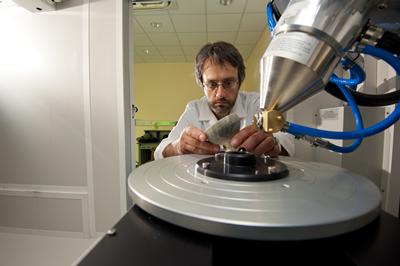Southampton lends expertise to world-leading research facility for lab-based X-ray computed tomography

The University of Southampton’s world-leading expertise in x-ray imaging will play a major role in the newly-funded National Research Facility (NRF) in Lab-based X-ray Computed Tomography (CT), set to launch in November this year.
The NRF will provide access and support for both academia and industry, embracing both first time users and more experienced researchers running cutting-edge 3D imaging experiments.
The X-ray CT NRF, to be based within the Henry Royce institute for advanced materials at the University of Manchester, represents a £10m investment over 5 years from the Engineering and Physical Sciences Research Council (EPSRC). The NRF will bring together the capability of existing facilities from Manchester, Southampton, University College London (UCL), the University of Warwick, and Diamond Light Source. Together, these five partners provide a unique and diverse shared capability to the UK.
Operating within one of the largest and most diverse engineering groupings in the UK, the µ-VIS X-ray Imaging Centre at Southampton provides 8 lab X-ray CT systems and the expertise of over 40 academic staff from across the University, serving a wide range of imaging needs, including aerospace structures, marine engineering, civil engineering and geotechnics, energy systems and biomedical research.
“We’re tremendously excited that Southampton will work as part of this major initiative which will define the UK as a global leader in X-ray CT,” said Professor Ian Sinclair, µ-VIS Academic Lead for Engineering at Southampton and founding Director of the µ-VIS X-ray Imaging Centre at Southampton.
“Within the NRF, we have an excellent opportunity to draw on over 10 years’ experience running one of the UK’s largest XCT scanners, taking a lead for imaging large-scale samples and engineering systems with dimensions in the order of meters, with weights in excess of 100kg” Professor Sinclair continued. “Furthermore, we will take a lead role in biomedical imaging, building upon several years collaboration with the University Hospital Southampton (UHS), the jointly operated NHS/University Biomedical Imaging Unit (BIU), and Wellcome, addressing basic research to near-clinical application.”
By bringing together and building on the complementary strengths of 5 of the country’s leading X-ray CT facilities, the NRF will position itself and the UK as a world leader for X-ray imaging. It will provide access to a suite of conventional and unique imaging capabilities, in situ environments and the resources needed for effective visualisation and analysis of the data, all with expert technical support.
The creation of the lab X-ray CT NRF across the five partners will enable expansion of X-ray CT capacity and expertise to support investigations in biomedical and life sciences, engineering and physical sciences, environmental sciences, humanities and cultural heritage. The new lab will support a range of industrial sectors, from additive manufacturing to civil engineering.
The NRF will also provide training and funded access to imaging facilities at the partner sites, as well as support and expertise to set up experiments and analyse the 3D data. The new equipment will ensure capacity as well as delivering unique new capabilities in X-ray CT.
Dr Tim Burnett from the University of Manchester said: “There is so much potential for X-ray imaging to add enormous value to our research and industrial challenges. I am delighted that this National Facility will open up access to this equipment but also provide the training, support and skills needed to help everyone exploit this technology. I am very excited about our partnership with Southampton, UCL and Warwick which will allow us to bring the latest developments in large sample imaging, metrology, phase contrast imaging and multiscale and fast in situ experimentation to the widest possible number of users.
Dr Andrew Wright, Head of Capital Infrastructure at EPSRC, added: “The X-ray CT facility will be a key component of EPSRC’s network of national research facilities, which support our research base to develop cutting edge techniques and make advances with societal and economic impact. It will provide researchers across academia and industry with the tools they need to break new ground in a wide range of fields, driving excellence and enhancing scientific productivity.”
X-ray computed tomography (XCT) produces 3D images showing internal and external features at microscopic detail, all achieved non-destructively. XCT can characterise objects as they are tested mechanically, heated or exposed to combinations of external conditions, simulating real-world environments, such as manufacturing of materials, geological processes, or movement of a knee joint. These in situ tests can be used to understand complex changes taking place inside things which can allow us, for example, to see a failure process happening, so that it can be designed against in the future.
Professor Sinclair is joined on the NRF project at Southampton by Dr Philipp Schneider, µ-VIS Academic Lead for Biomedical Imaging and Academic Director; Dr Richard Boardman, µ-VIS Principal Scientist; Dr Mark Mavrogordatoµ-VIS Operations Director; Dr Thomas Blumensath, µ-VIS Academic Lead for Image Processing;
Professor Simon Coles, Director of the Southampton-based UK National Crystallography Service and Physical Sciences Data-science Service; and Professor Simon Cox, Professor of Computational Methods at the University.